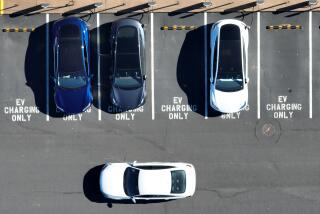Transport Funds: Unite or Perish
For decades, federal spending on transportation was dominated by the interstate highway system. That all ended in 1991 when the Congress approved an awkward mouthful known as the Intermodal Surface Transportation Efficiency Act, or ISTEA.
ISTEA was a welcome change, a sea change. It emphasized relieving congestion and improving air quality. It gave states much more discretion over the use of federal funds. And it focused attention on creating and improving connections between different modes of transportation, such as rail and truck access to the commercial harbors of Portland and Seattle.
Locally, a proposal to transform a cluttered section of Santa Monica Boulevard into a well-manicured and fast-moving avenue falls under ISTEA, which expires this year. The Santa Monica project, approved Wednesday by the Metropolitan Transportation Authority Board, has been appropriately scaled back from an eight-lane quasi-freeway, but without funding from ISTEA or its successor the project will be in jeopardy. The transportation act also contains seed money for research and funding for promising public projects. One is the Angels Walk Pedestrian Project in downtown Los Angeles.
Before ISTEA expires, Congress and the president must agree on how to divide as much as $174 billion among the states over the next six years. This is one of the federal government’s largest programs. Variations on how to split the pot have already been floated, with at least three competing options advanced by blocs of states and various members of Congress.
The importance of this moment to California cannot be overstated. Our collective local and state leadership and the usually discordant congressional delegation face a complicated review and hard decisions. For instance, ISTEA money is raised through the federal motor fuels tax and the states receive funds based on a formula that leaves some with more funding than their residents pay in and others with less. One option for settlement (known as “turnback”) would roll back federal oversight and much of the federal gas tax and let the states manage their own fuel taxes. A second idea would streamline ISTEA provisions, reducing programs involving management of transportation congestion, air quality and safety; it would also guarantee a uniform level of federal funds for the states. The third, dubbed “NEXTEA,” would largely keep the program intact.
The first two proposals raise concerns. In California, there is some question about whether residents would want to match the reduction in federal fuel taxes, penny for penny, with equally high state fuel taxes. That may be especially true since the state already needs a source of funding for at least $1.6 billion in toll bridge retrofitting and a new Bay Bridge in the San Francisco area.
California’s goals in the matter have been clearly stated by Gov. Pete Wilson and other state officials: more funding, fewer federal strings attached. At present, state transportation officials argue, we receive less in federal funding than California kicks in through the federal gas tax, although those figures are disputed in some quarters.
Arguably, California does deserve special consideration in terms of funding formulas. One-third of the nation’s imports come in through California, with 60% ending up beyond our state boundaries. That freight takes an inordinate toll on the state’s transportation infrastructure. If this funding formula inequity can be addressed, there will be little need for radical changes.
Other states will proffer their own reasons for special consideration. That is why it is so important for California to present a rare united front. The various sides on this national debate are staking out positions in continuing congressional hearings. California must set its own determined course, with its elected representatives in the vanguard.
More to Read
Sign up for Essential California
The most important California stories and recommendations in your inbox every morning.
You may occasionally receive promotional content from the Los Angeles Times.









